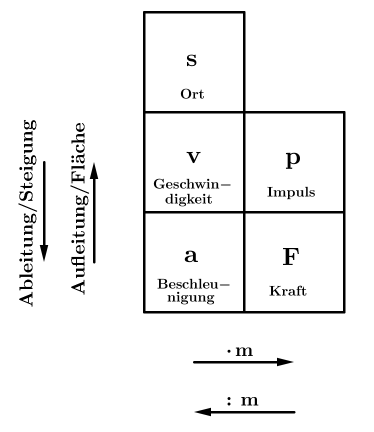Bewegungsdiagramme und Bewegungsgesetze beliebiger Bewegungen: Unterschied zwischen den Versionen
(→Übersichtliche Darstellung als Merkregel) |
(→Übersichtliche Darstellung als Merkregel) |
||
| Zeile 13: | Zeile 13: | ||
[[Datei:Bewegungsdiagramme_Merkregel.png|374px]] | [[Datei:Bewegungsdiagramme_Merkregel.png|374px]] | ||
| − | {| | + | {|class="wikitable" style="text-align: center; " |
| | | | ||
Ort <math>s</math> in <math>\rm m</math> | Ort <math>s</math> in <math>\rm m</math> | ||
| Zeile 31: | Zeile 31: | ||
in einem Kilogramm Masse.) | in einem Kilogramm Masse.) | ||
| − | | | + | |
| + | |valign="top"| | ||
Impuls <math>p</math> in <math>\rm Hy</math> | Impuls <math>p</math> in <math>\rm Hy</math> | ||
| + | |||
Wieviel Bewegung steckt drin? | Wieviel Bewegung steckt drin? | ||
| + | |||
| + | |||
| + | |||
<math>p=m\, v</math> | <math>p=m\, v</math> | ||
| Zeile 40: | Zeile 45: | ||
| | | | ||
Beschleunigung <math>a</math> in <math>\rm \frac{m}{s^2}</math> | Beschleunigung <math>a</math> in <math>\rm \frac{m}{s^2}</math> | ||
| + | |||
<math>a=\dot v \approx \frac{\triangle v}{\triangle t}</math> | <math>a=\dot v \approx \frac{\triangle v}{\triangle t}</math> | ||
| Zeile 48: | Zeile 54: | ||
auf ein Kilogramm Masse.) | auf ein Kilogramm Masse.) | ||
| − | | | + | |valign="top"| |
| − | + | ||
Kraft <math>F</math> in <math>\rm N</math> | Kraft <math>F</math> in <math>\rm N</math> | ||
| Zeile 55: | Zeile 60: | ||
<math>F=\dot p \approx \frac{\triangle p}{\triangle t}</math> | <math>F=\dot p \approx \frac{\triangle p}{\triangle t}</math> | ||
| + | |||
<math>F= m\, a</math> | <math>F= m\, a</math> | ||
Version vom 20. März 2014, 12:39 Uhr
Inhaltsverzeichnis
Beispiele
- Mit dem Skateboard/Inlinern sich von einer Wand abstoßen (Kraftmessplatte!)
- Sport: Einen Ball treten oder mit dem Schläger schlagen (Tennis, Golf, Fußball, ...) (Wie mißt man da die Kraft?)
- Sport: Sprung aus dem Stand oder mit "Schwungholen" (Kraftmessplatte!)
- Aufzug fahren (Kraftmessplatte!)
Allgemeine Formulierung des 2. Newtonschen Gesetzes
Die Kraft ist die zeitliche Änderungsrate des Impulses ("Ableitung der Impulsmenge nach der Zeit").
Übersichtliche Darstellung als Merkregel
|
Ort [math]s[/math] in [math]\rm m[/math] Wo ist das Ding? | |
|
Geschwindigkeit [math]v[/math] in [math]\rm \frac{m}{s}[/math] Wie schnell ist es? [math]v=\dot s \approx \frac{\triangle s}{\triangle t}[/math] [math]v=\frac{p}{m}[/math] (Entspricht dem Impuls in einem Kilogramm Masse.) |
Impuls [math]p[/math] in [math]\rm Hy[/math]
|
|
Beschleunigung [math]a[/math] in [math]\rm \frac{m}{s^2}[/math]
[math]a=\frac{F}{m}[/math] (Entspricht der Kraft auf ein Kilogramm Masse.) |
Kraft [math]F[/math] in [math]\rm N[/math] Wie wird gedrückt/gezogen? [math]F=\dot p \approx \frac{\triangle p}{\triangle t}[/math]
|
